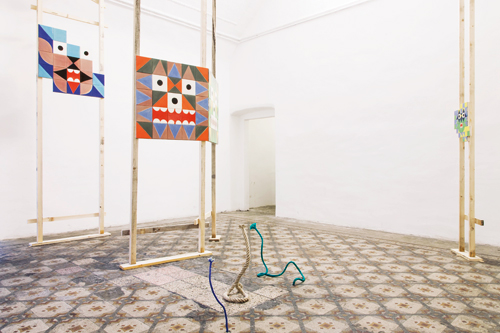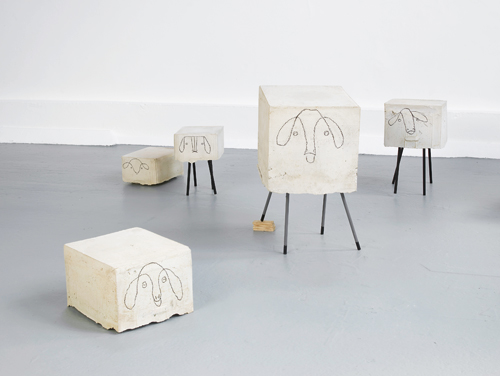I'm With Stupid
Using humour and ‘stupidity’, Judith Hopf tackles behavioural norms and art world expectations
Using humour and ‘stupidity’, Judith Hopf tackles behavioural norms and art world expectations

‘Unfetishistic’ is how Diedrich Diederichsen describes Judith Hopf’s work.1 With an understated concision characteristic of her practice, however, the artist herself describes her working method as an attempt to do something ‘that doesn’t put me in a bad mood’.2 What Diederichsen might call fetishistic, and what might put Hopf in a bad mood, would be art that bows to a diktat – be it art wholly oriented towards the market with its call for the constant output of saleable artefacts, or the stern bearing and formal rigour of art that sees itself as critical (of institutions).
Instead, Hopf is seen as an artist who addresses social issues, who deals with normativity and exclusion, institutionalized behaviour and restrictive roles. This sounds like the kind of work that would be applauded by the art world – its institutions and parts of its commercial sector – under the rubric of socially engaged art. Thematically as well as formally, Hopf’s work is informed by the post-painting spirit of the early 1990s with approaches based on concept/performance, object/installation, video/cinema.3 Her approach draws on this repertoire while subverting its rules by spicing up her interest in locations or social processes with deliberately foolish or slapstick humour, or disguising critique behind a mask of ‘stupidity’.4

Sheep, often viewed by humans as the epitome of stupidity and mindless herd behaviour, appear en masse in Flock of Sheep (2013). In Hopf’s bulky concrete rendering, the sheep also embody a direct and pointed site-specificity with the work created for the 2013 exhibition A Line May Lie in Lingen, home to one of the first commercially used atomic power stations (whose concrete shell is now waiting to be dismantled). Here, Hopf’s work resembles the fables in which animals represent human behavioural traits, voicing a social critique from behind a more or less obvious mask. But in spite of their specific context, the Lingen sheep with their cartoon-like faces, angular bodies and wobbly twig-like legs (in some cases requiring extra support provided by door stops) are capable, like many of Hopf’s works, of adapting quickly to new settings. With their paradoxical mix of hinted mobility (the concrete bodies are cast from cardboard packing cases for removals) and actual resistance to easy transport, the flock is a cunningly critical parody on the endless global transhipment of artworks, artists, visitors and exhibitions. Through their material, the sheep also comment on the changing aesthetic of the exhibition space – previously dominated by the white cube – referring to the Brutalist concrete architecture of Berlin’s PRAXES Center for Contemporary Art, where they were shown through the first half of 2014 as part of the exhibition cycle Untitled 1 – 4. In Liverpool, where they can currently be seen as part of Hopf’s contribution to this year’s biennial, they contrast with the romanticized decay of the Old Blind School.

From these examples, it is also clear that Hopf’s response to the need for endless production for commercial galleries, public institutions and cyclical events is to simply reject such expectations, among other reasons, so as not to overextend herself either physically or financially. And the principle of reusing works or using them differently applies not only to many of her shows but in some cases also to the work’s materials. Her floor-to-ceiling ‘lengths of bamboo’, for example, first installed in 2005 at Berlin’s Wand Boden Decke project space and a year later at Secession in Vienna, (Bambus, Bamboo, 2005), consist of a towering stack of ordinary drinking glasses. At PRAXES, two accidentally damaged works were turned into entirely new pieces: the untitled tile faces, whose colour scheme and mask-like stylization recalled Aztec artefacts, originally mounted in wooden frames, were trimmed and placed on puddles of black vinyl, either emerging from or submerging into their surfaces (untitled, 2014). Claude Lévi-Strauss’s concept of bricolage resonates here not only with Hopf’s formal approach but also in conceptual terms, in the way her works are open to new connections based on their changing context.

Instead of addressing the general via the particular, Hopf’s works focus from the outset on the behaviours and structures that come together in specific social, ideological or even economic manifestations. The fragile lengths of bamboo thus clearly refer to the plant’s rapid growth, and to its flexibility – the key requirement of the neoliberal age. At the Breitenau Memorial, a site of Nazi terror where Hopf rebuilt this precarious installation as part of dOCUMENTA (13) in 2012, both the work’s rapid vegetable growth and the need to approach it with care took on a whole new resonance alluding both to dangers of the rampant spread of ideologies and the fragility of human coexistence. A position somewhere between metaphor and taking a part for the whole is occupied by the basket sculptures made by Hopf for this year’s Liverpool Biennial (Untitled (Baskets), 2014). Cut open at the base or on one side, they seem to drift on a body of water, alluding here to the trade in colonial goods and slaves to which the port of Liverpool once owed its wealth. Yet in our globalized world, this work, too, will be capable, in many different places and contexts, of developing new and variously nuanced references to both historical and current forms of commodity trading with their own conditions of transport.

This narrative reduction that renders Hopf’s works so open to associations and so effective is joined in some cases by a very specific sense of humour. On the one hand, this allows a certain subversive quality (a quality it shares with certain kinds of stupidity, or rather feigned stupidity) and, on the other, a distance to one’s own actions that is both liberating and free of indignation. This concerns the artist’s attitude both to her own works and to the ills they deal with. So when Hopf wants to tell a story of exclusion and not fitting in, she sticks a friend into a huge polystyrene egg and has him wander around an angularly modernistic glass office building. His unusual girth makes him unable to pass through any of the standard door-ways (Some End of Things: The Conception of Youth, 2011). This tragicomic figure and his doomed endeavours recall both Chaplin and Kafka. The egg man is defeated by the dictatorial perversity of everyday life, and his stoic tackling of absurdity makes him all the more human.
The potential for identification via the detour of an animated inanimate object is also offered by Hopf’s Wartende Laptops (Waiting Laptops, 2009) and Erschöpfte Vasen (Exhausted Vases, 2013) that resonate with and embody all the things experienced in a society of overstretching, burnout and chronic exhaustion. The laughter prompted by the folded laptop figures with their unexpectant faces and the vases with their desperate grimaces (inspired by Saul Steinberg illustrations5) is a laughter that fosters self-knowledge. And of course this enfeeblement and stasis can also be attributed to these animated objects themselves, which unmistakably recall Cubist-Constructivist sculpture or Picasso’s ceramics, as well as possibly referring to the fatigued state of a modernism that has exhausted itself in all directions. In any case, it is evident that Hopf always has the formal idiom of modernism in mind, as seen both in the Brâncusi-like bamboo pillars and in the minimal cuboid volumes of the sheep.

Hopf’s gaze is always directed both outwards and inwards, for what is true on a small scale is also true on the large scale, and vice versa. When she speaks about constraints and mechanisms of exclusion, when she examines economic processes and their impact on people’s wellbeing and behaviour, she is always also referring to the art world. When, in The Elevator Curator (2005, with her now-gallerist Deborah Schamoni), she drives a group of artists and a curator into an accelerated frenzy of travel and production, or when, in her video Zählen! (Count!, 2008),6 she has a ‘mathematically gifted’ horse demonstrate the Clever Hans effect (based on a perfectly conditioned response to expectations), her focus is always also on the high-velocity madness of a globalized world with all its norms and control structures.
Translated by Nicholas Grindell
1 Diedrich Diederichsen, Außenbordmotor, in Judith Hopf, exhibition catalogue, Vienna Secession (Frankfurt: Revolver, 2007), pp. 5–7
2 Judith Hopf in conversation with the author, 2 July 2014
3 This is the genealogy of Hopf’s work traced by Sabeth Buchmann in Vita Passiva, or Shards Bring Love: On the Work of Judith Hopf, in: Afterall, Fall/Winter 2010, pp. 101–107
4 I only dare to speak of stupidity in the context of Hopf’s work because the artist herself names Avital Ronell’s philosophical treatise on the subject among her references. Ronell in turn refers to Robert Musil’s lecture Über die Dummheit (On Stupidity) in which a shrewd brand of stupidity is described as a survival strategy behind which an unwelcome cleverness can be disguised. Avital Ronell, Stupidity (Champaign: University of Illinois Press, 2002), 72f; Robert Musil: Über die Dummheit, lecture delivered in Vienna on 11 & 17 March 1937 (Berlin: Alexander Verlag, 2011)
5 See Buchmann, Vita Passiva, p. 105
6 This work is based on the case of an actual horse, Kluger Hans (Clever Hans), that was marketed as a mathematical miracle in the early 20th century. As studies later showed, the horse was not able to count at all; instead, it responded to physical signals from its interlocutor. Since then, behavioural scientists have used the term ‘Clever Hans effect’ to describe the phenomenon whereby an individual, rather than actually solving a set problem, develops a feeling for the expected result.














